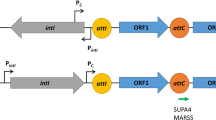Abstract
To allow the regulated expression of cloned genes inCandida albicans, a plasmid was constructed using the inducible promoter of theC. albicans MAL2 gene. To demonstrate that theMAL2 promoter could regulate cloned genes placed under its control, a fusion construct was made with the coding sequence of theC. albicans URA3 gene. This plasmid was introduced into a Ura− strain ofC. albicans using the process of restriction enzyme-mediated integration (REMI). This procedure involves the transformation of theBamHI-linearized plasmid in the presence ofBamHI enzyme. The majority of transformants generated contained insertions of the plasmid at chromosomalBamHI sites. All transformants examined were inducible forURA3 expression, which was determined by growth analysis and by measuring the level ofURA3 gene product activity. The Ura+ phenotype of the transformants was stable during growth under nonselective conditions. This system offers the advantages of stable transformation, easy recovery of integrated DNA, and inducible expression of genes inC. albicans.
Similar content being viewed by others
References
Ausubel F, Brent R, Kingston R, Moore D, Seidman J, Smith J, Struhl K (1989) Current protocols in molecular biology. Wiley, New York
Bodey G (1988) The emergence of fungi as major hospital pathogens. J Hosp Infect 11 (Suppl A):411–426
Cannon RD, Jenkinson HF, Shepard MG (1990) Isolation and nucleotide sequence of an autonomously replicating sequence (ARS) element functional inCandida albicans andSaccharomyces cerevisiae. Mol Gen Genet 221:210–218
Cannon RD, Jenkinson HF, Shepherd MG (1992) Cloning and expression ofCandida albicans ADE2 and proteinase genes on a replicative plasmid inCandida albicans and inSaccharomyces cerevisiae. Mol Gen Genet 235:453–457
Delbrück S, Ernst J (1993) Morphogenesis-independent regulation of actin transcript levels in the pathogenic yeastCandida albicans. Mol Microbiol 10:859–866
Fonzi WA, Irwin MY (1993) Isogenic strain construction and gene mapping inCandida albicans. Genetics 134:717–728
Geber A, Williamson PR, Rex JH, Sweeney EC, Bennet JE (1992) Cloning and characterization of aCandida albicans maltase gene involved in sucrose utilization. J Bacteriol 174:6992–6996
Gorman JA, Chan W, Gorman JW (1991) Repeated use ofGAL1 for gene disruption inCandida albicans. Genetics 129:19–24
Goshorn AK, Grindle SM, Scherer S (1992) Gene isolation by complementation inCandida albicans and applications to physical and genetic mapping. Infect Immun 60:876–884
Herreros E, Garcia-Sáez MI, Nombela C, Sánchez M (1992) A reorganizedCandida albicans DNA sequence promoting homologous non-integrative genetic transformation. Mol Microbiol 6:3567–3574
Hong SH, Marmur J (1987) Upstream regulator regions controlling the expression of the yeast maltase gene. Mol Cell Biol 7:2477–2483
Kelly R, Miller SM, Kurtz MB, Kirsch DR (1987) Directed mutagenesis inCandida albicans: one-step gene disruption to isolateura3 mutants. Mol Cell Biol 7:199–207
Kurtz MB, Cortelyou MW, Kirsch DR (1986) Integrative transformation ofCandida albicans, using a clonedCandida ADE2 gene. Mol Cell Biol 6:142–149
Kurtz MB, Cortelyou MW, Miller SM, Lai M, Kirsch DR (1987) Development of autonomously replicating plasmids forCandida albicans. Mol Cell Biol 7:209–217
Kuspa A, Loomis WF (1992) Tagging developmental genes inDictyostelium by restriction enzyme-mediated integration of plasmid DNA. Proc Natl Acad of Sci USA 89:8803–8807
Liberman I, Kornberg A, Simms E (1955) Enzymatic synthesis of pyrimidine nucleotides. Orotidine-5′-phosphate and uridine-5′-phosphate. J Biol Chem 215:403–415
Lowry OH, Rosebrough NJ, Farr AL, Randall RJ (1951) Protein measurement with the Folin phenol reagent. J Biol Chem 193:265–275
Miller J (1992) A short course in bacterial genetics. Cold Spring Harbor Laboratory Press, Cold Spring Harbor, New York
Myers K, Sypherd P, Fonzi W (1995) Use ofURA3 as a reporter of gene expression inC. albicans. Curr Genet 27:243–248
Ni B, Needleman R (1990) Identification of upstream activating sequence ofMAL and the binding sites for theMAL63 activator ofSaccharomyces cerevisiae. Mol Cell Biol 10:3797–3800
Pfaller MA (1994) Epidemiology and control of fungal infections. Clin Infect Dis 19(Suppl 1):S8-S13
Ram SP, Sullivan PA, Shepard MG (1983) The in situ assay ofCandida albicans enzymes during yeast growth and germ-tube formation. J Gen Microbiol 129:2367–2378
Sambrook J, Fritsch EF, Maniatis T (1989) Molecular cloning: a laboratory manual (2nd edn). Cold Spring Harbor Laboratory Press, Cold Spring Harbor, New York
Scherer S, Stevens DA (1988) ACandida albicans dispersed, repeated gene family and its epidemiologic applications. Proc Natl Acad Sci USA 85:1452–1456
Schiestl RH, Petes TD (1991) Integration of DNA fragments by illegitimate recombination inSaccharomyces cerevisiae. Proc Natl Acad Sci USA 88:7585–7589
Umezu K, Amaya T, Yoshimoto A, Tomita K (1971) Purification and properties of orotidine-5′-phosphate pyrophosphorylase and orotidine-5′-phosphate decarboxylase from bakers' yeast. J Biochem 70:249–262
Yao B, Marmur J, Sollitti P (1993) Construction of glucose-repressible yeast expression vectors. Gene 137:223–226
Author information
Authors and Affiliations
Additional information
Communicated by E. Cerdá-Olmedo
Deceased, December 15, 1995
Rights and permissions
About this article
Cite this article
Brown, D.H., Slobodkin, I.V. & Kumamoto, C.A. Stable transformation and regulated expression of an inducible reporter construct inCandida albicans using restriction enzyme-mediated integration. Molec. Gen. Genet. 251, 75–80 (1996). https://doi.org/10.1007/BF02174347
Received:
Accepted:
Issue Date:
DOI: https://doi.org/10.1007/BF02174347




